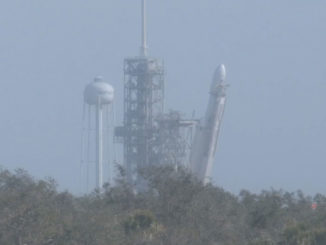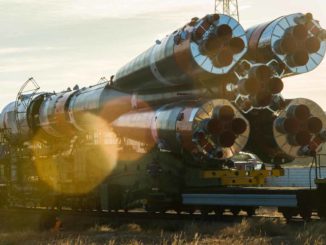
SpaceX test-fired a Falcon 9 rocket Wednesday afternoon at NASA’s Kennedy Space Center in Florida, clearing a major hurdle before it launches Saturday night — weather permitting — with a four-person crew heading for the International Space Station.
The 215-foot-tall (65-meter) Falcon 9 rocket ignited its nine Merlin 1D main engines at 3:49 p.m. EST (2049 GMT) Wednesday, and throttled up to full power for several seconds. Hold-down clamps kept the launcher firmly on the ground as the engines powered up to generate 1.7 million pounds of thrust.
A rush of exhaust emerged from the flame trench at pad 39A, and a low rumble could be heard for miles around as Falcon 9 completed a pre-flight test-firing ahead of a launch scheduled for 7:49 p.m. EST Saturday (0049 GMT Sunday) with three NASA astronauts and a Japanese space flier bound for the space station.
The mission will be SpaceX’s first operational crew rotation flight using the Falcon 9 rocket and Crew Dragon capsule, following a successful piloted Crew Dragon test flight to the space station earlier this year.
The static fire test Wednesday was a customary rehearsal SpaceX performs before most of its missions. Stationed inside the launch control center firing room near Kennedy’s iconic Vehicle Assembly Building, the SpaceX launch team managed an automated countdown that loaded kerosene and liquid oxygen propellants into the brand new two-stage rocket three miles away on pad 39A.
After the engine firing, the launch team drained the rockets of propellants and readied for the next activity — a “dry dress rehearsal” planned for Thursday in which NASA commander Mike Hopkins, pilot Victor Glover, mission specialist Shannon Walker, and Japanese astronaut Soichi Noguchi will put on their pressure suits and climb into their Crew Dragon “Resilience” capsule at pad 39A.
Hopkins and his crewmates will use the rehearsal to run through the steps they will take on launch pad, from suit-up at NASA’s crew quarters to the ride out to pad 39A inside two Tesla Model X automobiles. Once at the pad, the astronauts will ride an elevator up the service structure and walk across the crew access arm to the white room, where SpaceX’s closeout crew will help them into the spaceship.
The dress rehearsal Thursday will not involve filling the Falcon 9 rocket with propellants.
SpaceX and NASA officials plan to convene a Launch Readiness Review on Friday to assess the status of preparations for Saturday night’s launch opportunity. They will also discuss the weather forecast.
In a tweet confirming a successful outcome to the static fire test Wednesday afternoon, SpaceX said officials are monitoring weather conditions for liftoff from Kennedy Space Center and along the rocket’s flight path to the northeast over the Atlantic Ocean.
Mission managers will track winds, wave conditions, lightning, and precipitation at more than 50 locations in the Atlantic Ocean off the U.S. East Coast, east of the Canadian Maritime provinces, and just west of Ireland. The Crew Dragon capsule could abort and splash down in those areas in the event of a launch failure.
The first official weather forecast for the Falcon 9’s launch opportunity Saturday night shows a 60% probability of favorable conditions for liftoff at the Florida spaceport. The primary weather concern is with cumulus clouds, according to the U.S. Space Force’s 45th Weather Squadron.
The forecast does not take into account wind and wave conditions along the Crew Dragon spacecraft’s ascent corridor across the Atlantic, or upper level wind criteria for the Falcon 9’s climb through the atmosphere.
A backup launch opportunity is available at 7:27 p.m. EST Sunday (0027 GMT Monday).
Once the launch occurs, the Crew Dragon will fly an automated rendezvous profile to link up with the space station, delivering Hopkins, Glover, Walker, and Noguchi to the orbiting outpost for a six-month expedition. They will join three other crew members currently living and working on the space station.
Email the author.
Follow Stephen Clark on Twitter: @StephenClark1.



